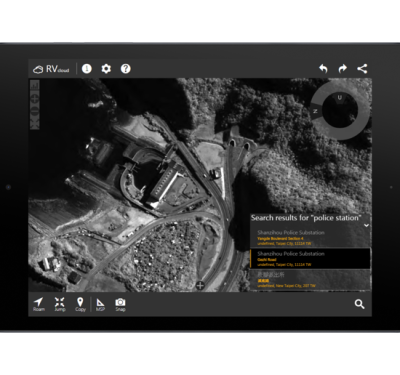NASA, working with industry partners, is pushing advanced air mobility concepts forward, with unmanned cargo delivery a likely prospect in the near future.
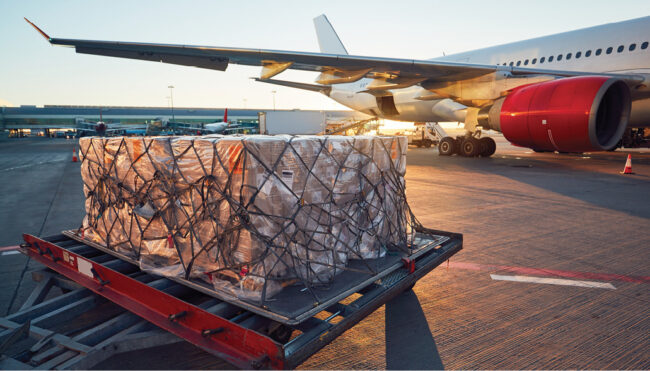
When most people think of NASA, they picture the moon landings, the space station and other celestial achievements. But the first A in NASA stands for aeronautics, and the agency is working on technology that could change society as much as the space race did—advanced air mobility (AAM).
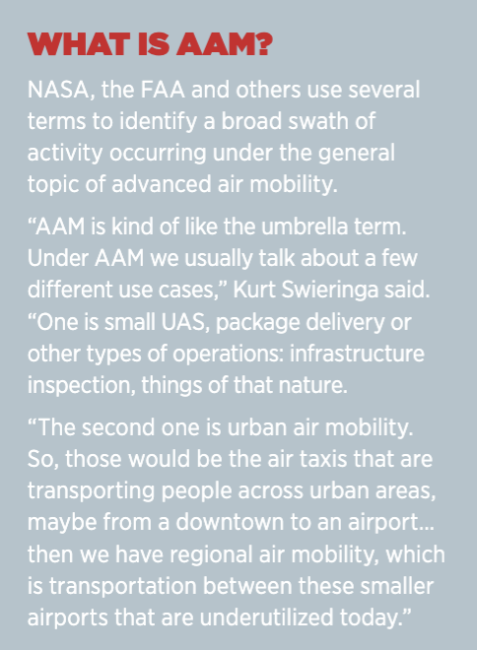
NASA is working with industry and government partners to create a new AAM system, which would see people and cargo flown around cities and from town to town in vehicles that resemble super-sized drones. It would be a revolution in transportation, replacing thousands of car and truck trips with electric-powered, zero-emission Jetsons-style journeys.
As a component of its AAM work, NASA has been working with industry partners on research that could bear fruit in the next few years, namely using autonomous general aviation aircraft or vehicles of a similar size to deliver cargo to regional airports.
“We’re really looking at taking a lot of these new entrants and conventional operations and integrating them much more closely together so that they can interoperate kind of seamlessly in shared airspace,” Kurt Swieringa, NASA’s Air Traffic Management—eXploration deputy project manager for technology, told Inside Unmanned Systems.
NASA works with industry partners on various aspects of AAM, including vehicle testing, simulations, airspace operations, infrastructure and more.
“One of the roles we do at NASA is we develop concepts and try to identify the architectural kind of components that are needed to make that concept of operations in reality. So, that’s one of the roles that we’re doing specifically for urban air mobility,” Swieringa said.
Industry partners are developing hardware and software for their aircraft, “but then also we’ll look at some technologies that we think may be needed down the road to scale these operations, either to higher densities, higher numbers, or to scale to higher levels of autonomy,” he said.
For instance, an unmanned cargo airline company may want to have numerous aircraft monitored by a single operator. “So, we’ll look at some of the technologies that are needed to enable some of those more future enhancements,” he said.
The initial National Campaign, as NASA calls it, included demonstration flights, using vehicles from Reliable Robotics Corp., Wisk Aero LLC and Joby Aviation, all based in California. (The second phase is under way, with partners Electra Aero of Virginia, OverAir of California, Hyundai Motor Corp.’s Supernal of Washington, D.C., and Ellis & Associates, a consulting arm of Laguna Technologies of California.)
Swieringa said one role for NASA is to serve as connective tissue between the FAA and industry and be a thought leader in some areas. “Another one is doing the actual research to flush out, what should the system requirements be? What types of services are really necessary?”
NASA brings a lot to the table, Reliable Robotics CEO Robert Rose told Inside Unmanned Systems. It has some “very sophisticated air traffic control simulation abilities,” including an ATC simulator at NASA Ames Research Center.
Reliable Robotics, like some of the other companies NASA has worked with, runs a traditional Part 135 cargo airline carrying packages for FedEx. Its Cessnas are piloted, but the company plans to automate the system over time.
Rose said one main benefit of NASA’s involvement with AAM is providing an independent, trusted third party to help the FAA understand these complicated systems and trust they will work safely.
“There are other labs they can lean on, they lean on MITRE and MIT Lincoln Labs for a lot of this stuff as well,” Rose said. “But NASA has a credibility and independence here that is a little bit different than those other labs.”
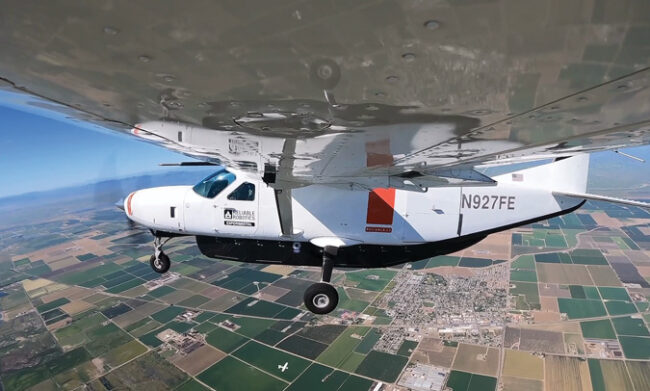

Photo courtesy of Reliable Robotics.
TECHNICAL CHALLENGES
While many of the technologies and technical challenges for AAM have been worked on for some time, “others need some additional work,” Swieringa said. “When we look at uncrewed cargo delivery, I’m really talking about scaled operations that happen routinely in the airspace.
“There’s a lot of opportunities I think today or in the near future to start doing pilot operations in specific areas that have some constraints. But when we look at the scalable operations, I think that we’re still seeing detect and avoid as a barrier. There’s been a lot of work done on that. We’ve got standards for it,” but the industry still needs certified systems that can handle that critical aspect of unmanned operations.
As part of its work with Reliable Robotics, NASA and the company tackled the detect-and-avoid puzzle by using FAA primary surveillance radar (PSR) data as part of that solution. “This data may be used in detect and avoid systems that would support future autonomous flight in the advanced air mobility system,” NASA said in a statement.
Tests involved Reliable Robotics flying its Cessna 172 Skyhawk and 208 Caravan aircraft from San Martin Airport in California along preselected flight paths between Marina and Stockton, California. The NASA team worked with FAA
radar engineers, the Oklahoma University Advanced Radar Research Center, Reliable Robotics, NASA’s Armstrong Flight Research Center in Edwards, California, and NASA’s Ames Research Center in Silicon Valley, California, to collect the data. Data from at least eight sources including aircraft, radar and weather were integrated for analysis as a foundation for future research.
“This work with NASA was to validate some simulation work that had been done by us and others previously, essentially to test the efficacy of using primary surveillance radar for detect and avoid,” Rose said. “Step one was to go out and very deliberately run a few encounters while recording the raw…primary surveillance radar data stream. So, that’s all we did. These data sets existed previously, but if you don’t have anything to necessarily correlate to, it’s hard to make comparisons. So, we needed to go out and have a plan and then also record our own telemetry of our understanding of aircraft position very precisely, so that we could then compare what the aircraft thought they were doing for an encounter versus what the PSR systems picked up.”
Rose said it’s still “early days” on the work, and more research will likely be done, “but we thought it’d be worth highlighting this work, because I think it’s personally exciting that NASA’s making investments in this space and wants to be a part of the solution.”
The agency plans to combine this research with other data and complete a model and a report to share with the FAA, and make the research public this fall.
“We’re a convenient partner here because we’ve got two aircraft that are instrumented, of two different types,” Rose said, a Cessna Caravan and a Cessna 172. “So, we’ve got all the instrumentation to very precisely position those planes. We gave all that data to NASA and now they’re working on it.”
Another must-have for cargo operations is automatic landing and takeoff to further reduce crew requirements.
“Today, we have the ability to do automatic landing,” Swieringa said, but using category III instrument landing systems are “very expensive, very few airports have it. How can you do this routinely at these smaller airports? That’s something that industry’s working on. That’s not something that we’re working on at NASA right now, but that’s definitely one of the challenges—surface operations.
“So, there are a lot of different pieces that all have to come together to really make these routine operations work,” he said.
Reliable Robotics may have an answer, Rose said.
“We’ve developed a set of navigation technologies, we call it reliable navigation, that fuses GPS, WAAS GPS, radar altimeter, inertial, air data, magnetometers, basically all of the normal sensors you might have on a plane. It’s fusing all of these together to come up with, not just a higher precision estimate of aircraft position, but also a higher integrity solution so that this navigation source can be used as the sole source of navigation,” he said.
For future unmanned flights, operators will need a system they can trust as the sole source, he said. The company has a set of algorithms that sit on top of all the other navigation components and monitors their integrity. The company plans to put the system into its first certification program on the Caravan, he said. “We’ve been working on this for four or five years now. We finally have gotten the FAA to accept using this system as a navigation source.
“What this means to you as a user or as a pilot, it means you can now use this navigation source not just as the single navigation source, but also you can use it all the way down to the runway in zero visibility conditions. So, this is the technology, in our view, that’s going to enable ‘decision-height zero’ auto land, and you can auto land without any infrastructure at the airport. You don’t need an instrument landing system. If you have this system on the plane, you could fly it all the way down to the ground.”
ECONOMIC IMPACT
Having a vibrant cargo and transportation network between regional airports could be an economic boon to many parts of the country, as well as in places like Europe.
“I think there’s a lot of potential for that,” Swieringa said. “It remains to be seen how the economics will shake out and where investments will be made. But I certainly hope it is because I think there’s a lot of potential, particularly for the regional air mobility concept.”
Swieringa said he can relate to the need. A resident of Hampton, Virginia, he often travels to Washington, D.C., which gives him a choice of spending hours in traffic or dealing with inconvenient train schedules.
“It would be really great if I could just fly to a regional airport there, grab an Uber or hop on a bus or Metro after that and get to downtown,” he said.
Several states have embraced the idea of AAM for cargo delivery and moving people. Swieringa said Ohio has been very active, and Alaska is “energized by a lot of these concepts. Alaska’s very aviation oriented and they’re very interested in how they could use some of these concepts to improve the transportation of supplies and people,” he said.
Last year, for example, Ohio published a study of AAM, saying it would lay the foundation for creating an AAM ecosystem in the state, home to the Wright brothers and a long history of aviation. In the study, the state also declared that “Ohio intends to apply AAM for the safe, efficient, and equitable transportation of people and goods throughout the state.”
“When we look at our transportation in the United States, I can fly long distances relatively easily, right? We have a pretty good network of airports. I can take short distances in my car pretty easily unless I’m in the D.C. area,” Swieringa said with a laugh. “But, those kind of mid-level trips are really challenging. Like if I try to book a flight from Norfolk [Virginia] to D.C., that actually can be quite expensive and not really viable for that trip. So, everyone just ends up driving three, four hours.”
Using existing airport infrastructure in the United States, routes could be tailored to meet demand, making it more flexible than rail systems. “You can tune your routes to the demand relatively easily,” he said.
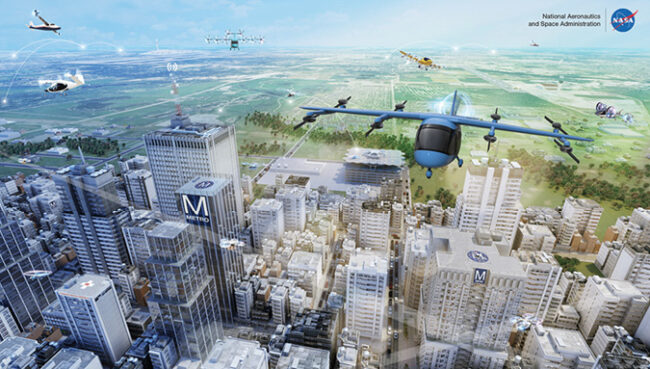
WHEN?
Participants in the AAM world are generally resistant to giving timetables as to when things will happen, but the industry is moving forward and Swieringa said he thinks operations in at least two areas can begin soon.
“I think for uncrewed aircraft, cargo goes first, but for urban air mobility and eVTOLs [electric vertical takeoff and landing vehicles], they’re also looking at using piloted operations with them, and that could be something that has near-term potential.”
He believes we’ll see operations in those areas in five to seven years, maybe some piloted UAM operations even sooner than that.
Standards and some technical issues need to be resolved, but “there’s a lot of progress being made very quickly, so I don’t think it’s too far off. I’m always hesitant to broadcast these specific timeframes because I might have, next thing, Reliable Robotics come in and say, ‘no, we can do that faster.’ You know, time will tell.”
For his part, Rose said the “Jetsons” world of routine flying cars is “probably 10 to 20 years out, but progress is being made. In the more near term, “it’s going to be cargo, passenger acceptance is going to be an issue.”
From the FAA’s point of view, it doesn’t matter if the aircraft is carrying cargo or people, “because the bottom line is it’s a big plane and it could do a lot of damage to infrastructure on the ground,” he said. “For our certification, we actually don’t get to take credit for the fact that it’s a cargo plane. It’s still an 8,000-plus pound aircraft carrying hundreds of pounds of fuel.”
Overall, he said AAM acceptance, whether for cargo or people, will be “very incremental, very gradual.”



